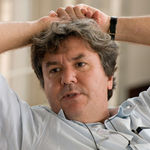
Marco Foiani
e-mail: marco.foiani AT ifom.eu
affiliation: IFOM-FIRC Institute of Molecular Oncology
research area(s): Cell Biology, Molecular Biology
Course:
Molecular Medicine: Molecular Oncology and Computational Biology
University/Istitution: Università di Milano, UNIMI-SEMM
University/Istitution: Università di Milano, UNIMI-SEMM
Full Prof. in Molecular Biology, University of Milan and
Head of the Genome Integrity Laboratory and Scientific Director at
F.I.R.C. Institute of Molecular Oncology Foundation
Member of the Italian Society of Genetics (AGI), of the Italian Society of Biophisics and Molecular Biology (SIBBM) and of the European School of Molecular Medicine (SEMM). Since 2009 member of the editorial board of Cell and since 2010 member of the Academia Europaea.
Degree in Biological Sciences and PhD school in Molecular Biology at the University of Milan. "Adriano Buzzati Traverso" postdoctoral fellowship at the University of Milan. "Fogarty" postdoctoral fellowship at the National Institute of Child Heath and Human Development (NIH), Bethesda, (U.S.A.)
Head of the Genome Integrity Laboratory and Scientific Director at
F.I.R.C. Institute of Molecular Oncology Foundation
Member of the Italian Society of Genetics (AGI), of the Italian Society of Biophisics and Molecular Biology (SIBBM) and of the European School of Molecular Medicine (SEMM). Since 2009 member of the editorial board of Cell and since 2010 member of the Academia Europaea.
Degree in Biological Sciences and PhD school in Molecular Biology at the University of Milan. "Adriano Buzzati Traverso" postdoctoral fellowship at the University of Milan. "Fogarty" postdoctoral fellowship at the National Institute of Child Heath and Human Development (NIH), Bethesda, (U.S.A.)
Regulation of DNA replication during cell cycle and in response to DNA damage (1991-present)
As a junior group leader (1991-1994) he has studied the cell cycle-dependent regulation of the lagging strand replication apparatus using yeast as a model system. During that period he was able to show that the lagging strand polymerase is postranslationally regulated during both the mitotic and meiotic cell cycle. This regulation requires the activity of the Cyclin B/Cdc28 kinase.
More recently (1995-present) he has been focussed his studies in the regulatory mechanisms that control DNA replication in response to DNA damage. Particularly, he has characterised the role of the DNA damage-induced checkpoint response in controlling the integrity of replicating chromosomes.
As a junior group leader (1991-1994) he has studied the cell cycle-dependent regulation of the lagging strand replication apparatus using yeast as a model system. During that period he was able to show that the lagging strand polymerase is postranslationally regulated during both the mitotic and meiotic cell cycle. This regulation requires the activity of the Cyclin B/Cdc28 kinase.
More recently (1995-present) he has been focussed his studies in the regulatory mechanisms that control DNA replication in response to DNA damage. Particularly, he has characterised the role of the DNA damage-induced checkpoint response in controlling the integrity of replicating chromosomes.
From 2010 on
1. Robert T., Vanoli F., Chiolo I., Shubassi G., Bernstein K.A., Rothstein R., Botrugno O.A., Parazzoli D., Oldani A., Minucci S., Foiani M. (2011) HDACs link the DNA damage response, processing of double-strand breaks and autophagy. Nature; 471(7336), 74-9.
2. Fachinetti D., Bermejo R., Cocito A., Minardi S., Katou Y., Kanoh Y., Shirahige K., Azvolinsky A., Zakian V.A., Foiani M. (2010) Replication termination at eukaryotic chromosomes is mediated by Top2 and occurs at genomic loci containing pausing elements. Molecular Cell 39(4), 595-605.
3. Ferrari E., Lucca C., Foiani M. (2010) A lethal combination for cancer cells: Synthetic lethality screenings for drug discovery. Eur J Cancer; 46(16), 2889-95.
4. Liberi G., Foiani M. The double life of Holliday junctions. Cell Res. 20(6), 611-3 (2010).
5. Branzei D., Foiani M. (2010) Maintaining genome stability at the replication fork. Nat Rev Mol Cell Biol. 11(3), 208-19.
6. Branzei D., Foiani M. (2010), Leaping forks at inverted repeats. Genes Dev. 24(1), 5-9.
1. Robert T., Vanoli F., Chiolo I., Shubassi G., Bernstein K.A., Rothstein R., Botrugno O.A., Parazzoli D., Oldani A., Minucci S., Foiani M. (2011) HDACs link the DNA damage response, processing of double-strand breaks and autophagy. Nature; 471(7336), 74-9.
2. Fachinetti D., Bermejo R., Cocito A., Minardi S., Katou Y., Kanoh Y., Shirahige K., Azvolinsky A., Zakian V.A., Foiani M. (2010) Replication termination at eukaryotic chromosomes is mediated by Top2 and occurs at genomic loci containing pausing elements. Molecular Cell 39(4), 595-605.
3. Ferrari E., Lucca C., Foiani M. (2010) A lethal combination for cancer cells: Synthetic lethality screenings for drug discovery. Eur J Cancer; 46(16), 2889-95.
4. Liberi G., Foiani M. The double life of Holliday junctions. Cell Res. 20(6), 611-3 (2010).
5. Branzei D., Foiani M. (2010) Maintaining genome stability at the replication fork. Nat Rev Mol Cell Biol. 11(3), 208-19.
6. Branzei D., Foiani M. (2010), Leaping forks at inverted repeats. Genes Dev. 24(1), 5-9.
No projects are available to students for the current accademic year.

